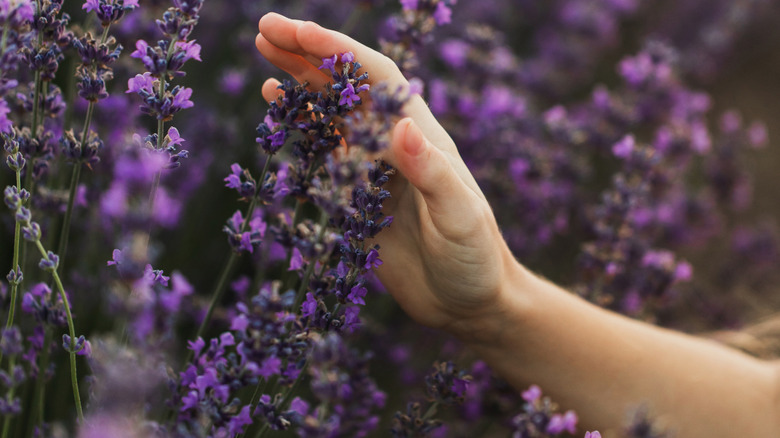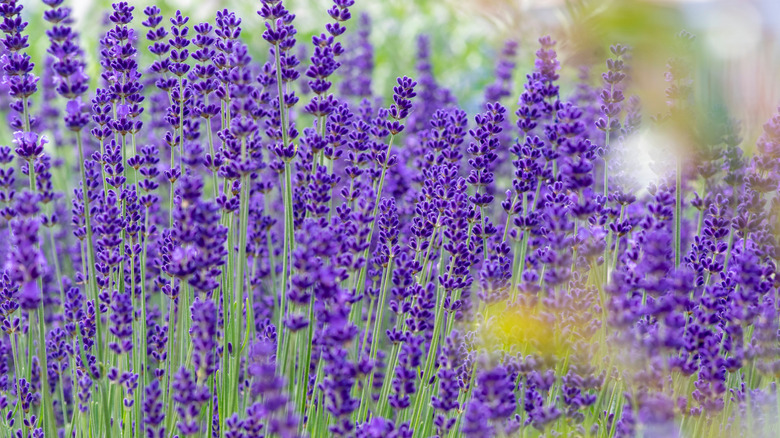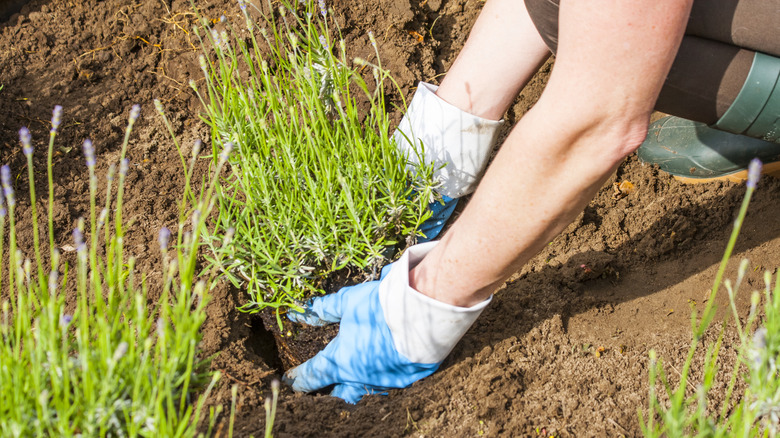These Low-Growing Lavender Varieties Are The Perfect Natural Mulch Alternative
Mulch can help your garden by improving soil moisture by slowing the evaporation of water, protecting from erosion, suppressing weeds, and moderating temperatures, but there are some cons to mulching as well. Mulch can erode with heavy rain, and certain kinds of mulch can negatively impact your soil by drawing nitrogen out of the soil as it decomposes or by smothering existing plants. The good news is that you can get the benefits of mulch with a beautiful and natural alternative: low-growing lavender plants, like English lavender.
Lavender is an herb that is classified as a perennial, evergreen subshrub with a variety of species, including some low-growing ones that make suitable mulch alternatives. Lavender is native to European Mediterranean regions, and it is a very resistant genus that can survive with little water. These plants feature lovely flowers in colors including multiple shades of purple, blue, white, and pink, and the plant is known for having fragrant leaves. There are some stunning lavender varieties that you can plant together for an aesthetic garden, but you can also use varieties as mulch alternatives.
Lavender roots reach deep into the soil, helping to prevent soil erosion. The shade provided by lavender plants also means that weeds will have a lower chance of getting the sunlight they need to grow. This means that lavender can help suppress weeds, although it may not be as effective as mulching or other weed control methods. A low-growing lavender variety that is dense enough may also slow the evaporation of water from the soil in the same way.
Best lavender varieties to use as mulch alternatives
If you are interested in growing lavender as a natural mulch alternative, there are quite a few dwarf varieties that make viable options. Exploring the many options and choosing the best one for your desired landscaping aesthetic based on height and required conditions is the best way to find a viable mulch alternative for your yard, but there are three varieties worth highlighting.
First, there is the Little Lady variety of English lavender (Lavandula angustifolia). This bushy shrub is one of the shortest lavender varieties, and these shrubs can be grown close together, giving you better coverage. The mature height of this variety is between 6 and 12 inches, and it spreads about 12 to 18 inches wide. It features pale lilac or blue flowers in the summer and silver-gray leaves.
The Nana Alba variety of English lavender is another good choice because it maintains a round shape with little pruning. With a mature height between 12 and 16 inches and a mature width between 18 and 24 inches, this plant is a low-maintenance option. Rather than the typical blues and purples of lavender, this plant has white flowers and is great as a perennial border, but it is toxic to dogs, cats, and horses.
Finally, if you want continuous blooms and to grow your plants from seeds, then Lacy Frills may be the English lavender variety for you. The mature height of this white flower variety is between 12 and 14 inches, and the spread is between 10 and 12 inches.
How to grow and maintain lavender
Lavender is generally considered easy to grow and maintain, including the English lavender varieties that work well as mulch alternatives. Lavender does best in a soil that drains well, and the plants require at least six hours of direct sunlight per day. On the USDA hardiness scale, zones 5 to 10 are acceptable climates for lavender. When you first plant lavender, make sure that the soil has enough moisture so that the roots do not dry out. Also, there are some plants that you will want to avoid growing with lavender in the garden, so use some caution when deciding where to place your lavender. Although low-growing lavender varieties will not grow as tall as regular varieties, you may still want to prune in order to achieve certain shapes and dense branching. If you do wish to do so, prune in the late fall by cutting just above green buds on lower stems. If your preparation and care fail, you may need to fall back on these foolproof ways to bring your dying lavender plants back to life.
Overall, lavender is a mulch alternative that is easy to grow and maintain, and it adds a lovely fragrance and pop of color to your garden. If you are looking for the benefits of mulch but want to change to a natural option, then lavender plants, particularly the English lavender varieties of Little Lady, Nana Alba, and Lacy Frills, are a great place to start.


